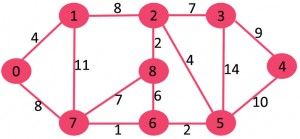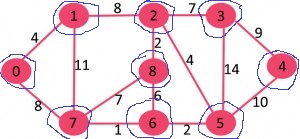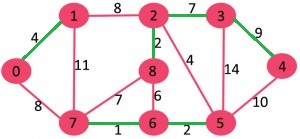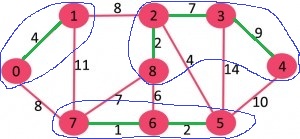我们已经讨论了以下关于最小生成树的主题。
最小生成树问题的应用
Kruskal 的最小生成树算法
Prim 的最小生成树算法
在这篇文章中,讨论了 Boruvka 的算法。与 Prim 和 Kruskal 的算法一样,Boruvka 的算法也是一种贪心算法。下面是完整的算法。
1) Input is a connected, weighted and un-directed graph.
2) Initialize all vertices as individual components (or sets).
3) Initialize MST as empty.
4) While there are more than one components, do following
for each component.
a) Find the closest weight edge that connects this
component to any other component.
b) Add this closest edge to MST if not already added.
5) Return MST.
以下是上述算法背后的思想(该思想与 Prim 的 MST 算法相同)。
生成树意味着必须连接所有顶点。因此必须连接两个不相交的顶点子集(上面讨论过)以形成生成树。并且它们必须与最小权重边相连以使其成为最小生成树。
让我们通过下面的例子来理解算法。

最初 MST 是空的。每个顶点都是单个组件,如下图中以蓝色突出显示。 
对于每个组件,找到将其连接到其他组件的最便宜的边。
Component Cheapest Edge that connects
it to some other component
{0} 0-1
{1} 0-1
{2} 2-8
{3} 2-3
{4} 3-4
{5} 5-6
{6} 6-7
{7} 6-7
{8} 2-8 最便宜的边缘用绿色突出显示。现在 MST 变为 {0-1, 2-8, 2-3, 3-4, 5-6, 6-7}。 
经过上述步骤,组件为{{0,1}、{2,3,4,8}、{5,6,7}}。组件用蓝色包围。 
我们再次重复该步骤,即,对于每个组件,找到将其连接到其他组件的最便宜的边。
Component Cheapest Edge that connects
it to some other component
{0,1} 1-2 (or 0-7)
{2,3,4,8} 2-5
{5,6,7} 2-5最便宜的边缘用绿色突出显示。现在 MST 变成 {0-1, 2-8, 2-3, 3-4, 5-6, 6-7, 1-2, 2-5} 
在这一阶段,只有一个分量 {0, 1, 2, 3, 4, 5, 6, 7, 8} 具有所有边。由于只剩下一个组件,我们停止并返回 MST。
执行:
下面是上述算法的实现。输入图表示为边的集合,并使用联合查找数据结构来跟踪组件。
C/C++
// Boruvka's algorithm to find Minimum Spanning
// Tree of a given connected, undirected and
// weighted graph
#include
// a structure to represent a weighted edge in graph
struct Edge
{
int src, dest, weight;
};
// a structure to represent a connected, undirected
// and weighted graph as a collection of edges.
struct Graph
{
// V-> Number of vertices, E-> Number of edges
int V, E;
// graph is represented as an array of edges.
// Since the graph is undirected, the edge
// from src to dest is also edge from dest
// to src. Both are counted as 1 edge here.
Edge* edge;
};
// A structure to represent a subset for union-find
struct subset
{
int parent;
int rank;
};
// Function prototypes for union-find (These functions are defined
// after boruvkaMST() )
int find(struct subset subsets[], int i);
void Union(struct subset subsets[], int x, int y);
// The main function for MST using Boruvka's algorithm
void boruvkaMST(struct Graph* graph)
{
// Get data of given graph
int V = graph->V, E = graph->E;
Edge *edge = graph->edge;
// Allocate memory for creating V subsets.
struct subset *subsets = new subset[V];
// An array to store index of the cheapest edge of
// subset. The stored index for indexing array 'edge[]'
int *cheapest = new int[V];
// Create V subsets with single elements
for (int v = 0; v < V; ++v)
{
subsets[v].parent = v;
subsets[v].rank = 0;
cheapest[v] = -1;
}
// Initially there are V different trees.
// Finally there will be one tree that will be MST
int numTrees = V;
int MSTweight = 0;
// Keep combining components (or sets) until all
// compnentes are not combined into single MST.
while (numTrees > 1)
{
// Everytime initialize cheapest array
for (int v = 0; v < V; ++v)
{
cheapest[v] = -1;
}
// Traverse through all edges and update
// cheapest of every component
for (int i=0; i edge[i].weight)
cheapest[set1] = i;
if (cheapest[set2] == -1 ||
edge[cheapest[set2]].weight > edge[i].weight)
cheapest[set2] = i;
}
}
// Consider the above picked cheapest edges and add them
// to MST
for (int i=0; iV = V;
graph->E = E;
graph->edge = new Edge[E];
return graph;
}
// A utility function to find set of an element i
// (uses path compression technique)
int find(struct subset subsets[], int i)
{
// find root and make root as parent of i
// (path compression)
if (subsets[i].parent != i)
subsets[i].parent =
find(subsets, subsets[i].parent);
return subsets[i].parent;
}
// A function that does union of two sets of x and y
// (uses union by rank)
void Union(struct subset subsets[], int x, int y)
{
int xroot = find(subsets, x);
int yroot = find(subsets, y);
// Attach smaller rank tree under root of high
// rank tree (Union by Rank)
if (subsets[xroot].rank < subsets[yroot].rank)
subsets[xroot].parent = yroot;
else if (subsets[xroot].rank > subsets[yroot].rank)
subsets[yroot].parent = xroot;
// If ranks are same, then make one as root and
// increment its rank by one
else
{
subsets[yroot].parent = xroot;
subsets[xroot].rank++;
}
}
// Driver program to test above functions
int main()
{
/* Let us create following weighted graph
10
0--------1
| \ |
6| 5\ |15
| \ |
2--------3
4 */
int V = 4; // Number of vertices in graph
int E = 5; // Number of edges in graph
struct Graph* graph = createGraph(V, E);
// add edge 0-1
graph->edge[0].src = 0;
graph->edge[0].dest = 1;
graph->edge[0].weight = 10;
// add edge 0-2
graph->edge[1].src = 0;
graph->edge[1].dest = 2;
graph->edge[1].weight = 6;
// add edge 0-3
graph->edge[2].src = 0;
graph->edge[2].dest = 3;
graph->edge[2].weight = 5;
// add edge 1-3
graph->edge[3].src = 1;
graph->edge[3].dest = 3;
graph->edge[3].weight = 15;
// add edge 2-3
graph->edge[4].src = 2;
graph->edge[4].dest = 3;
graph->edge[4].weight = 4;
boruvkaMST(graph);
return 0;
}
// Thanks to Anukul Chand for modifying above code. Python
# Boruvka's algorithm to find Minimum Spanning
# Tree of a given connected, undirected and weighted graph
from collections import defaultdict
#Class to represent a graph
class Graph:
def __init__(self,vertices):
self.V= vertices #No. of vertices
self.graph = [] # default dictionary to store graph
# function to add an edge to graph
def addEdge(self,u,v,w):
self.graph.append([u,v,w])
# A utility function to find set of an element i
# (uses path compression technique)
def find(self, parent, i):
if parent[i] == i:
return i
return self.find(parent, parent[i])
# A function that does union of two sets of x and y
# (uses union by rank)
def union(self, parent, rank, x, y):
xroot = self.find(parent, x)
yroot = self.find(parent, y)
# Attach smaller rank tree under root of high rank tree
# (Union by Rank)
if rank[xroot] < rank[yroot]:
parent[xroot] = yroot
elif rank[xroot] > rank[yroot]:
parent[yroot] = xroot
#If ranks are same, then make one as root and increment
# its rank by one
else :
parent[yroot] = xroot
rank[xroot] += 1
# The main function to construct MST using Kruskal's algorithm
def boruvkaMST(self):
parent = []; rank = [];
# An array to store index of the cheapest edge of
# subset. It store [u,v,w] for each component
cheapest =[]
# Initially there are V different trees.
# Finally there will be one tree that will be MST
numTrees = self.V
MSTweight = 0
# Create V subsets with single elements
for node in range(self.V):
parent.append(node)
rank.append(0)
cheapest =[-1] * self.V
# Keep combining components (or sets) until all
# compnentes are not combined into single MST
while numTrees > 1:
# Traverse through all edges and update
# cheapest of every component
for i in range(len(self.graph)):
# Find components (or sets) of two corners
# of current edge
u,v,w = self.graph[i]
set1 = self.find(parent, u)
set2 = self.find(parent ,v)
# If two corners of current edge belong to
# same set, ignore current edge. Else check if
# current edge is closer to previous
# cheapest edges of set1 and set2
if set1 != set2:
if cheapest[set1] == -1 or cheapest[set1][2] > w :
cheapest[set1] = [u,v,w]
if cheapest[set2] == -1 or cheapest[set2][2] > w :
cheapest[set2] = [u,v,w]
# Consider the above picked cheapest edges and add them
# to MST
for node in range(self.V):
#Check if cheapest for current set exists
if cheapest[node] != -1:
u,v,w = cheapest[node]
set1 = self.find(parent, u)
set2 = self.find(parent ,v)
if set1 != set2 :
MSTweight += w
self.union(parent, rank, set1, set2)
print ("Edge %d-%d with weight %d included in MST" % (u,v,w))
numTrees = numTrees - 1
#reset cheapest array
cheapest =[-1] * self.V
print ("Weight of MST is %d" % MSTweight)
g = Graph(4)
g.addEdge(0, 1, 10)
g.addEdge(0, 2, 6)
g.addEdge(0, 3, 5)
g.addEdge(1, 3, 15)
g.addEdge(2, 3, 4)
g.boruvkaMST()
#This code is contributed by Neelam Yadav输出:
Edge 0-3 included in MST
Edge 0-1 included in MST
Edge 2-3 included in MST
Weight of MST is 19关于 Boruvka 算法的有趣事实:
1) Boruvka 算法的时间复杂度为 O(E log V),与 Kruskal 和 Prim 算法相同。
2) Boruvka 的算法被用作在线性时间 O(E) 内工作的更快随机算法中的一个步骤。
3) Boruvka 算法是最古老的最小生成树算法,由 Boruuvka 于 1926 年发现,早在计算机出现之前。该算法是作为构建高效电力网络的一种方法而发布的。
锻炼:
上面的代码假设输入图是连接的,如果给出一个断开的图,它就会失败。扩展上述算法,使其也适用于断开连接的图并生成森林。
参考:
http://en.wikipedia.org/wiki/Bor%C5%AFvka%27s_algorithm
如果您希望与专家一起参加现场课程,请参阅DSA 现场工作专业课程和学生竞争性编程现场课程。